1993 CADILLAC FLEETWOOD turn signal
[x] Cancel search: turn signalPage 180 of 386
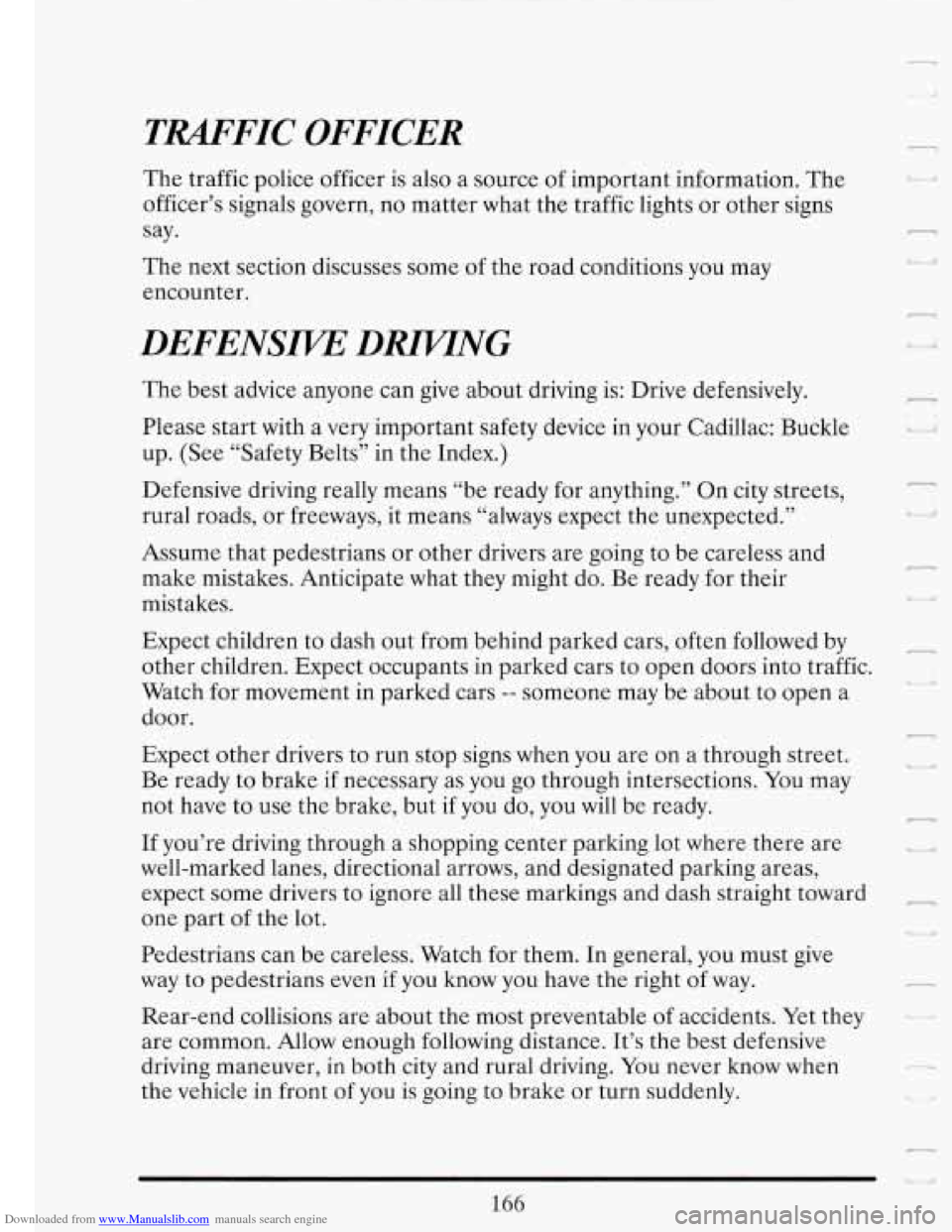
Downloaded from www.Manualslib.com manuals search engine TRAFFIC OFFICER 7 .. I: The traffic police officer is also a source of important information. The
officer’s signals govern, no matter what the traffic lights or other signs
say.
The next section discusses some of the road conditions you may
encounter.
DEFENSIVE DlUVTNG
The best advice anyone can give about driving is: Drive defensively.
Please start with a very important safety device
in your Cadillac: Buckle
up. (See “Safety Belts” in the Index.)
Defensive driving really means “be ready for anything.’’ On city streets,
rural roads, or freeways, it means “always expect the unexpected.”
Assume that pedestrians or other drivers are going to be careless and
make mistakes. Anticipate what they might do. Be ready for their
mistakes.
Expect children to dash out from behind parked cars, often followed by
other children. Expect occupants in parked cars to open doors into traffic.
Watch for movement
in parked cars -- someone may be about to open a
door.
Expect other drivers to run stop signs when you are on a through street.
Be ready to brake if necessary as you
go through intersections. You may
not have to use the brake, but
if you do, you will be ready.
If you’re driving through a shopping center parking lot where there are
well-marked lanes, directional arrows, and designated parking areas,
expect some drivers
to ignore all these markings and dash straight toward
one part of the lot.
Pedestrians can be careless. Watch for them. In general, you must give
way to pedestrians even if you know you have the right of way.
Rear-end collisions are about the most preventable of accidents. Yet they
are common. Allow enough following distance.
It’s the best defensive
driving maneuver,
in both city and rural driving. You never know when
the vehicle in front of you is going to brake or turn suddenly.
166
n
U i I‘
n
u
! I,
r
r
d
-
1
Page 197 of 386
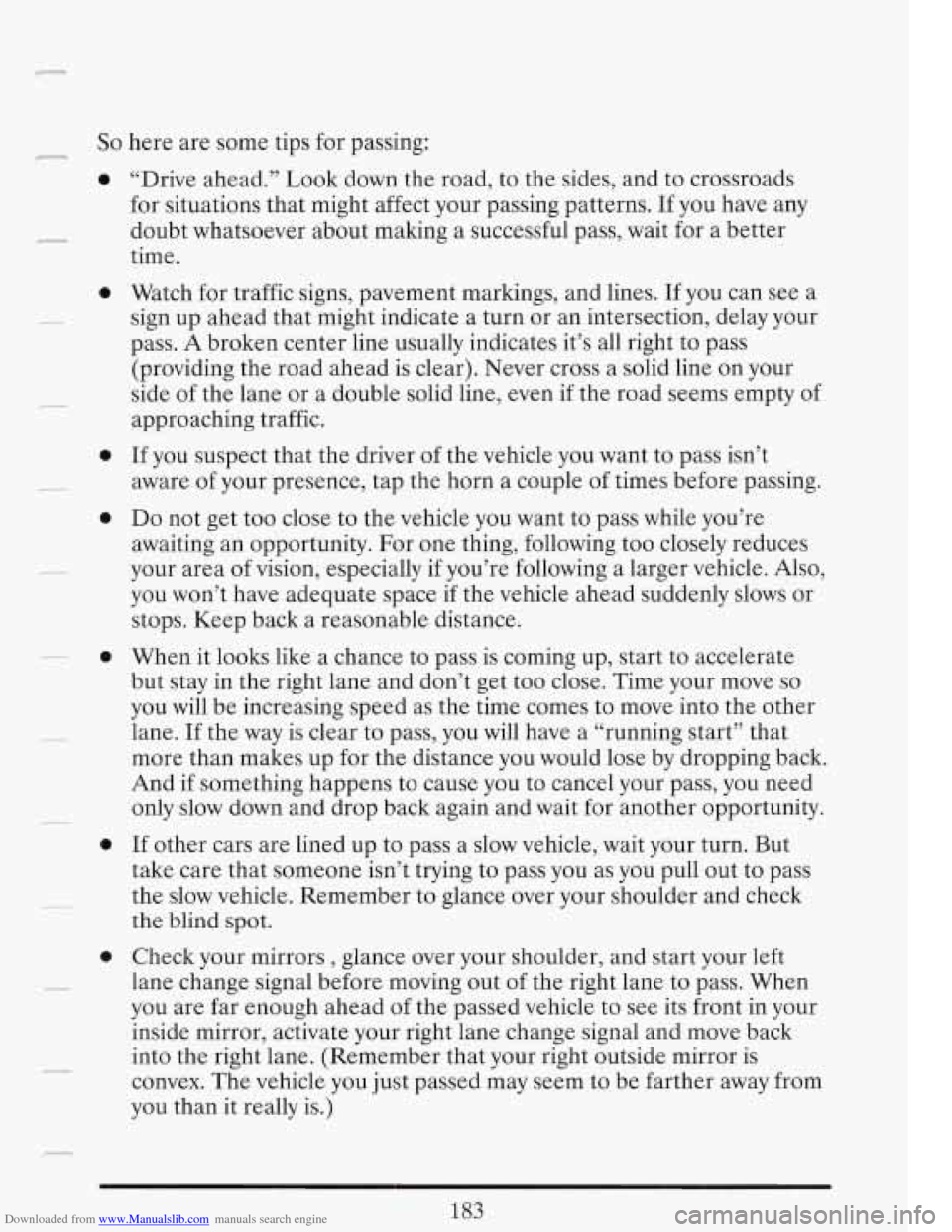
Downloaded from www.Manualslib.com manuals search engine So here are some tips for passing:
0
r
0
0
0
._ 0
0
0
“Drive ahead.” Look down the road, to the sides, and to crossroads
for situations that might affect your passing patterns.
If you have any
doubt whatsoever about making a successful pass, wait for
a better
time.
Watch for traffic signs, pavement markings, and lines. If you can see a
sign up ahead that might indicate a turn or an intersection, delay your
pass.
A broken center line usually indicates it’s all right to pass
(providing the road ahead is clear). Never cross a solid line on your
side
of the lane or a double solid line, even if the road seems empty of
approaching traffic.
If you suspect that the driver of the vehicle you want to pass isn’t
aware
of your presence, tap the horn a couple of times before passing.
Do not get too close to the vehicle you want to pass while you’re
awaiting an opportunity. For one thing, following too closely reduces
your area of vision, especially if you’re following a larger vehicle.
Also,
you won’t have adequate space if the vehicle ahead suddenly slows or
stops. Keep back a reasonable distance.
When it looks like a chance to pass is coming up, start to accelerate
but stay in the right lane and don’t get
too close. Time your move so
you will be increasing speed as the time comes to move into the other
lane. If the way is clear to pass, you will have a “running start” that
more than makes up for the distance you would lose by dropping back.
And if something happens
to cause you to cancel your pass, you need
only slow down and drop back again and wait for another opportunity.
If other cars are lined up to pass a slow vehicle, wait your turn. But
take care that someone isn’t trying to pass you as you pull out to pass
the slow vehicle. Remember to glance over your shoulder and check
the blind spot.
Check your mirrors
, glance over your shoulder, and start your left
lane change signal before moving out of the right lane to pass. When
you are far enough ahead of the passed vehicle to see its front in your
inside mirror, activate your right lane change signal and move back
into the right lane. (Remember that your right outside mirror is
convex. The vehicle you just passed may seem to be farther away from
you than it really is.)
Page 201 of 386
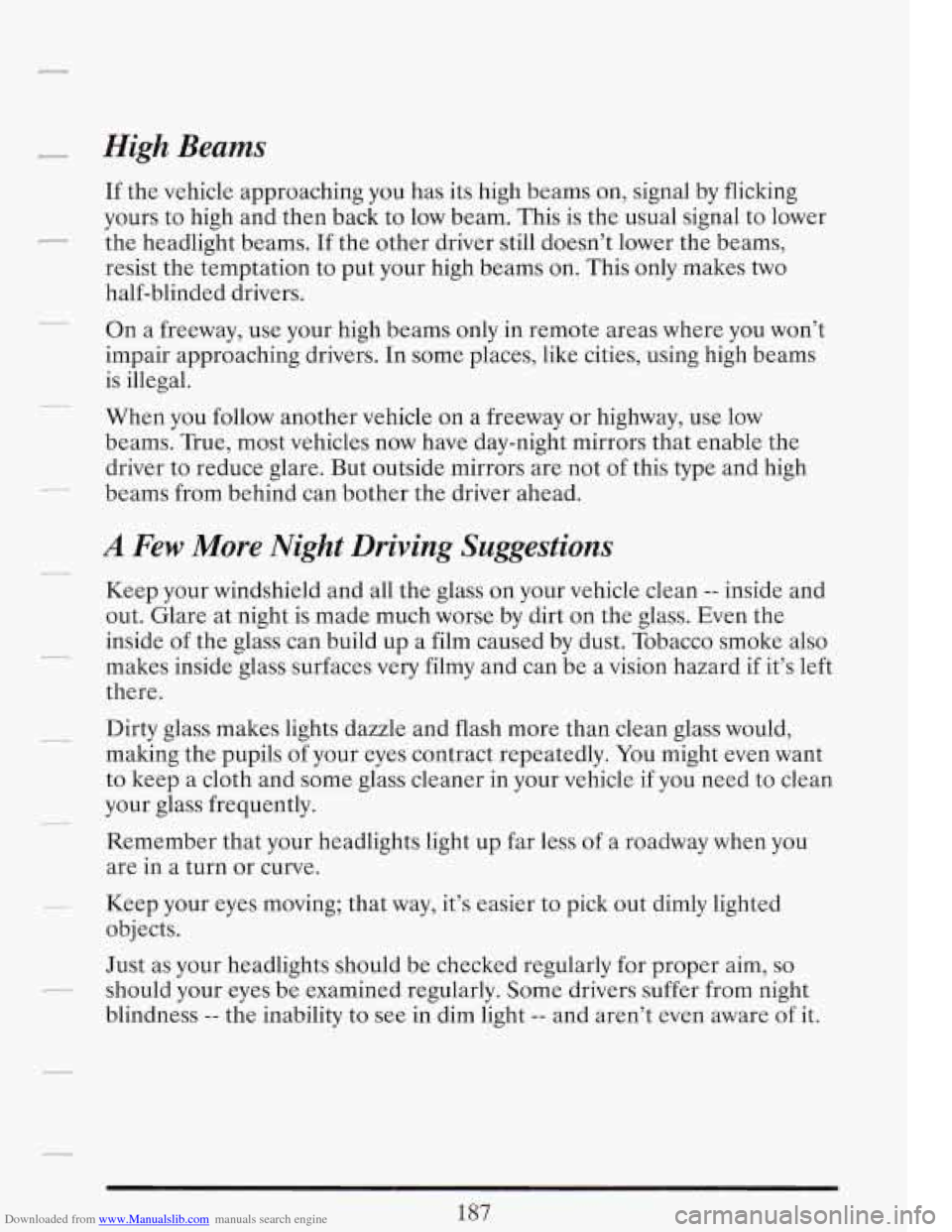
Downloaded from www.Manualslib.com manuals search engine r High Beams
If the vehicle approaching you has its high beams on, signal by flicking
yours to high and then back to low beam. This is the usual signal to lower
the headlight beams.
If the other driver still doesn’t lower the beams,
resist the temptation to put your high beams on. This only
makes two
half-blinded drivers.
- On a freeway, use your high beams only in remote areas where you won’t
impair approaching drivers. In some places, like cities, using high beams
is illegal.
When you follow another vehicle on a freeway or highway, use low
beams. True, most vehicles now have day-night mirrors that enable the
driver to reduce glare. But outside mirrors are not of this type and high
beams from behind can bother the driver ahead.
-
-
A Few More Night Driving Suggestions
-
Keep your windshield and all the glass on your vehicle clean -- inside and
out. Glare at night is made much worse by dirt on the glass. Even the
inside
of the glass can build up a film caused by dust. Tobacco smoke also
makes inside glass surfaces very filmy and can be a vision hazard
if it’s left
there. -
~ Dirty glass makes lights dazzle and flash more than clean glass would,
making the pupils
of your eyes contract repeatedly. You might even want
to keep a cloth and some glass cleaner in your vehicle if you need to clean
your glass frequently.
Remember that your headlights light up far less
of a roadway when you
are in a turn or curve.
-
_- Keep your eyes moving; that way, it’s easier to pick out dimly lighted
objects.
Just as your headlights should be checked regularly for proper aim, so
blindness
-- the inability to see in dim light -- and aren’t even aware of it.
- should your eyes be examined regularly. Some drivers suffer from night
187
Page 202 of 386
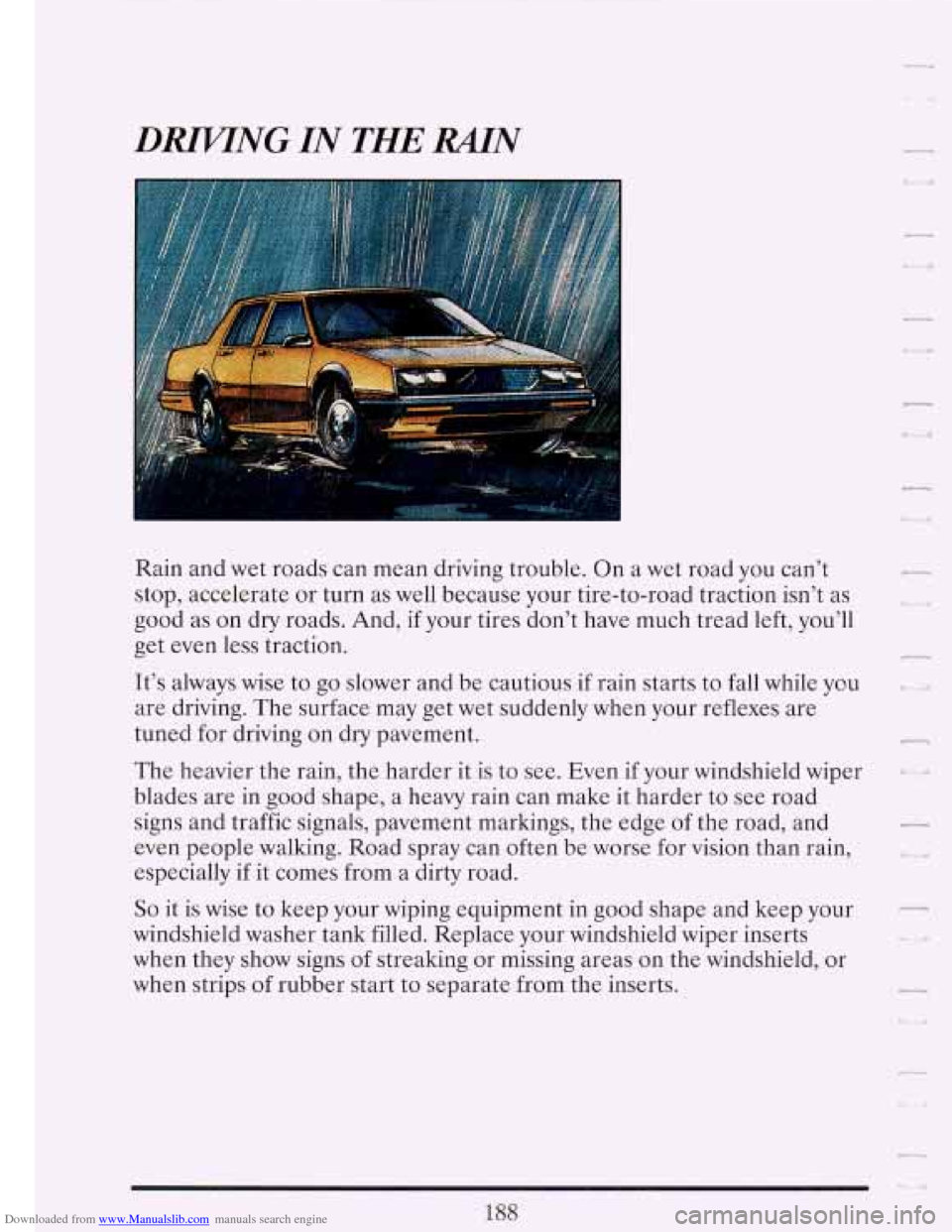
Downloaded from www.Manualslib.com manuals search engine DMNG IN THE MN
Rain and wet roads can mean driving trouble. On a wet road you can’t
stop, accelerate or turn as well because your tire-to-road traction isn’t as
good as on dry roads. And, if your tires don’t have much tread left, you’ll
get even less traction.
It’s always wise to
go slower and be cautious if rain starts to fall while yc.u II
are driving. The surface may get wet suddenly when your reflexes are
tuned for driving on dry pavement.
n
The heavier the rain, the harder it is to see. Even if your windshield wiper
blades are in good shape, a heavy rain can make it harder to see road
signs and traffic signals, pavement markings, the edge of the road, and
even people walking. Road spray can often be worse
for vision than rain,
especially if it comes from a dirty road.
So it is wise to keep your wiping equipment in good shape and keep your --
windshield washer tank filled. Replace your windshield wiper inserts
when they show signs of streaking or missing areas on the windshield, or
when strips
of rubber start to separate from the inserts.
188
Page 207 of 386
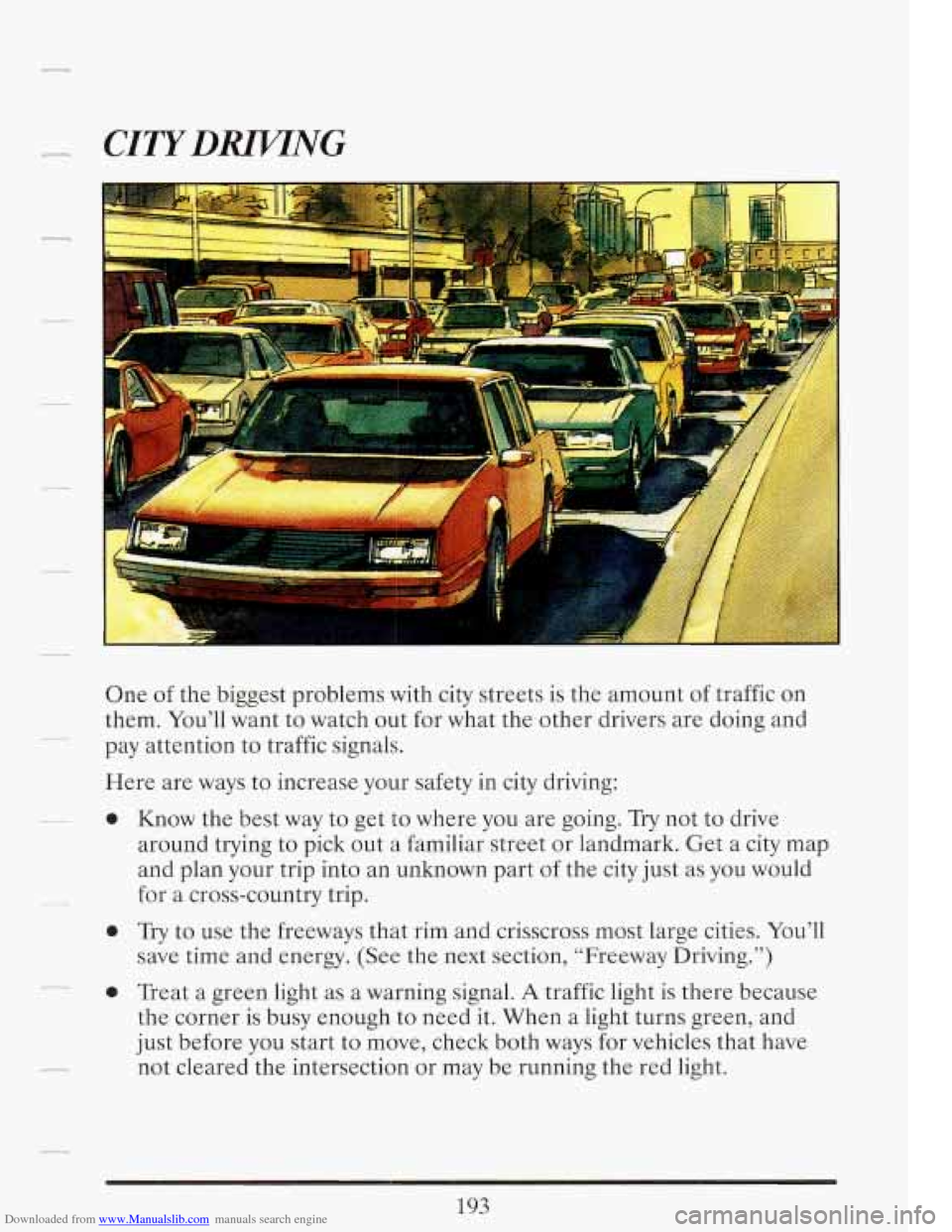
Downloaded from www.Manualslib.com manuals search engine One of the biggest problems with city streets is the amount of traffic on
them. You’ll want to watch out for what the other drivers are doing and
pay attention to traffic signals.
Here are ways to increase your safety in city driving:
---
0
.-._- 0
Know the best way to get to where you are going. Try not to drive
around trying to pick
out a familiar street or landmark. Get a city map
and plan your trip into an unknown part of the city just as
you would
for a cross-country trip.
Try to use the freeways that rim and crisscross most large cities. You’ll
save time and energy. (See the next section, “Freeway Driving.”)
Treat a green light as a warning signal.
A traffic light is there because
the corner is busy enough to need it. When a light turns green, and
just before you start to move, check both ways for vehicles that have
not cleared the intersection or may be running the red light.
193
Page 209 of 386
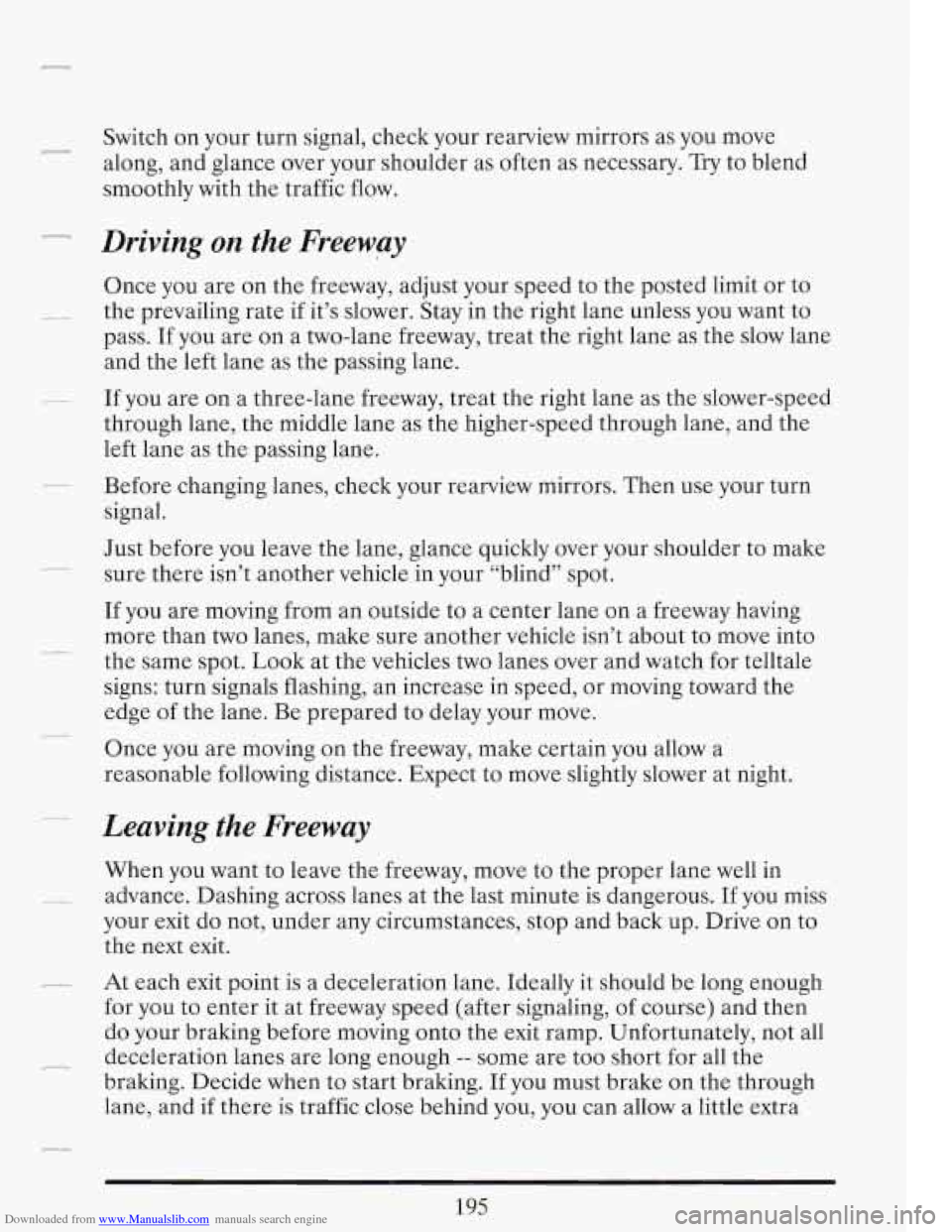
Downloaded from www.Manualslib.com manuals search engine r
Switch on your turn signal, check your rearview mirrors as you move
along, and glance over your shoulder as often as necessary.
Try to blend
smoothly with the traffic flow. c-
_I Driving on the Freeway
Once you are on the freeway, adjust your speed to the posted limit or to
-- the prevailing rate if it’s slower. Stay in the right lane unless you want to
pass.
If you are on a two-lane freeway, treat the right lane as the slow lane
and the left lane as the passing lane.
through lane, the middle lane as the higher-speed through lane, and the
left lane as the passing lane.
- If you are on a three-lane freeway, treat the right lane as the slower-speed
L_ Before changing lanes, check your rearview mirrors. Then use your turn
signal.
Just before you leave the lane, glance quickly over your shoulder to make
sure there isn’t another vehicle in your “blind” spot.
If you are moving from an outside to
a center lane on a freeway having
more than two lanes, make sure another vehicle isn’t about to move into
the same spot. Look at the vehicles
two lanes over and watch for telltale
signs: turn signals flashing, an increase in speed, or moving toward the
edge
of the lane. Be prepared to delay your move.
-
._.
_I
Once you are moving on the freeway, make certain you allow a
reasonable following distance. Expect to move slightly slower at night.
c_
Leaving the Freeway
When you want to leave the freeway, move to the proper lane well in
__ advance. Dashing across lanes at the last minute is dangerous. If you miss
your exit do not, under any circumstances, stop and back up. Drive on to
the next exit.
- At each exit point is a deceleration lane. Ideally it should be long enough
for you to enter it at freeway speed (after signaling, of course) and then
do your braking before moving onto the exit ramp. Unfortunately, not all
braking. Decide when to start braking.
If you must brake on the through
lane, and
if there is traffic close behind you, you can allow a little extra
- deceleration lanes are long enough -- some are too short for all the
195
Page 210 of 386
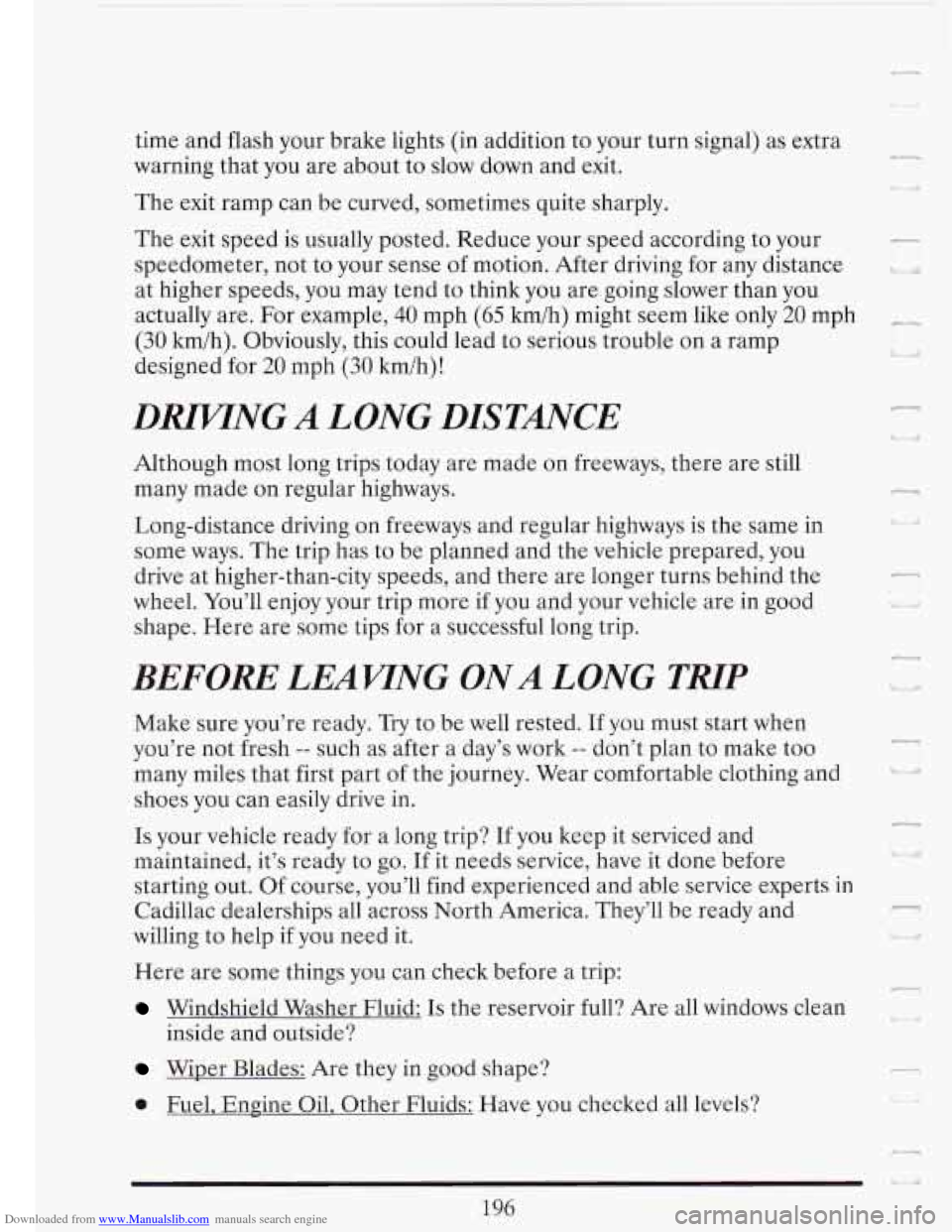
Downloaded from www.Manualslib.com manuals search engine time and flash your brake lights (in addition to your turn signal) as extra
warning that you are about to slow down and exit.
The exit ramp can be curved, sometimes quite sharply.
-.
U t I! The exit speed is usually posted. Reduce your speed according to your
speedometer, not to your sense
of motion. After driving for any distance
at higher speeds, you may tend to think you are going slower than you
actually are. For example,
40 mph (65 h/h) might seem like only 20 mph c_?
(30 km/h). Obviously, this could lead to serious trouble on a ramp
designed for
20 mph (30 kmih)!
I
L/
DRIVTNG A LONG DISTANCE
Although most long trips today are made on freeways, there are still
many made on regular highways.
Long-distance driving on freeways and regular highways is the same in
some ways. The trip has
to be planned and the vehicle prepared, you
drive at higher-than-city speeds, and there are longer turns behind the
wheel. You’ll enjoy your trip more if you and your vehicle are in good
shape. Here are some tips for a successful long trip.
BEFORE LEAWNG ONA LONG TRlP
Make sure you’re ready. Try to be well rested. If you must start when
you’re not fresh
-- such as after a day’s work -- don’t plan to make too
many miles that first part of the journey. Wear comfortable clothing and
shoes you can easily drive in.
.3
I
F i ! u
Is your vehicle ready for a long trip? If you keep it serviced and
maintained, it’s ready to
go. If it needs service, have it done before
starting out. Of course, you’ll find experienced and able service experts in
Cadillac dealerships all across North America. They’ll be ready and
7
willing to help if you need it. -1
Here are some things you can check before a trip:
Windshield Washer Fluid: Is the reservoir full? Are all windows clean
inside and outside?
Wiper Blades: Are they in good shape?
0 Fuel, Engine Oil, Other Fluids: Have you checked all levels?
Page 211 of 386
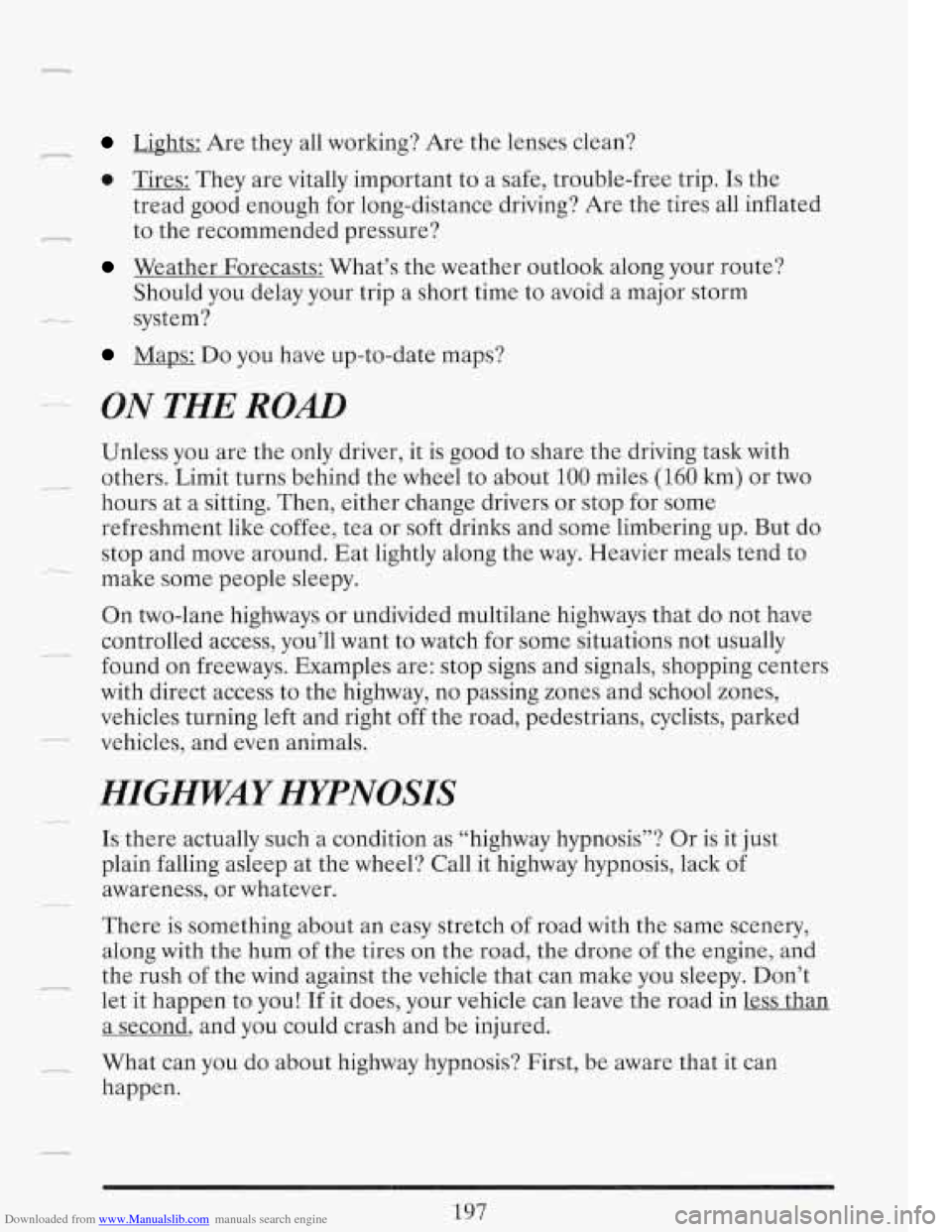
Downloaded from www.Manualslib.com manuals search engine - Lights: Are they all working? Are the lenses clean?
0 Tires: They are vitally important to a safe, trouble-free trip. Is the
tread good enough for long-distance driving? Are the tires all inflated
to the recommended pressure?
Weather Forecasts: What’s the weather outlook along your route?
Should you delay your trip a short time to avoid a major storm
system?
Maps: Do you have up-to-date maps?
_- - ON THE ROAD
Unless you are the only driver, it is good to share the driving task with
hours at a sitting. Then, either change drivers or stop for some
refreshment like coffee, tea or soft drinks and some limbering up. But do
stop and move around. Eat lightly along the way. Heavier meals tend
to
make some people sleepy.
- others. Limit turns behind the wheel to about 100 miles (160 km) or two
- ._
On two-lane highways or undivided multilane highways that do not have
controlled access, you’ll want to watch for some situations not usually
found on freeways. Examples are: stop signs and signals, shopping centers
with direct access to the highway,
no passing zones and school zones,
vehicles turning left and right off the road, pedestrians, cyclists, parked
vehicles, and even animals.
-
-
HIGWAY HYPNOSIS
c_
Is there actually such a condition as “highway hypnosis”? Or is it just
plain falling asleep at the wheel? Call it highway hypnosis, lack
of
awareness, or whatever.
There is something about an easy stretch of road with the same scenery,
along with the hum
of the tires on the road, the drone of the engine, and
- the rush of the wind against the vehicle that can make you sleepy. Don’t
let it happen
to you! If it does, your vehicle can leave the road in less than
a second, and you could crash and be injured.
happen.
__
- What can you do about highway hypnosis? First, be aware that it can